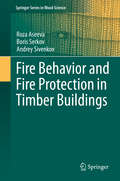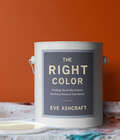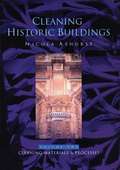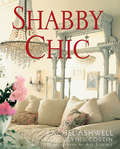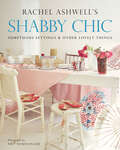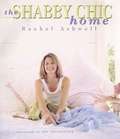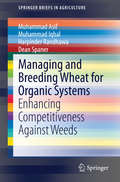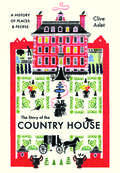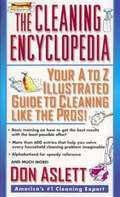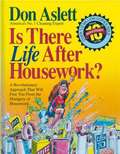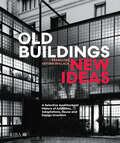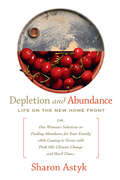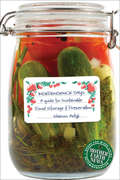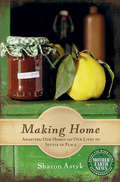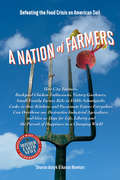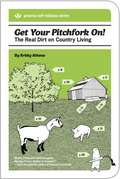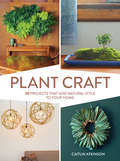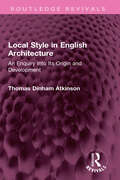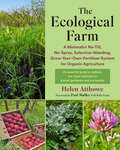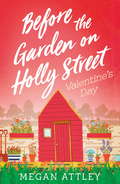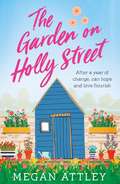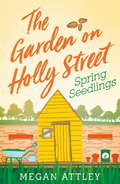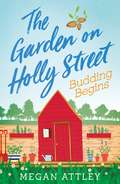- Table View
- List View
Fire Behavior and Fire Protection in Timber Buildings
by Roza Aseeva Boris Serkov Andrey SivenkovThis volume describes fire behavior and fire protection of timbers in outdoors and indoors application mainly in construction industry. The Authors' novel approach considers the relationship between various species and age of timbers and its fire behavior at different thermal and fire loads. Quantitative data of ignition speed and flame propagation as well as generation of heat, smoke and toxic products are discussed. Analysis of fire resistance of various types of building materials based on timber of different species as well as the novel data on the effect of natural and accelerated aging of timbers on its fire behavior are discussed. The main practical methods of fire protection of new and ancient timber buildings and structures to increase its fire resistance are considered. The book should be useful for a wide range of readers: chemists, physicists, material scientists, architects, engineers, constructors and restorers.
The Right Color
by Eve AshcraftThe definitive guide to paint by the nation’s most sought-after color consultantWhen Martha Stewart was developing her first paint collection, the Araucana Colors (based on the hues of her chickens’ eggs), she turned to the nation’s top color consultant: Eve Ashcraft. Eve helped Martha to pinpoint the colors of that enormously successful paint line, thus assisting in transforming an industry along the way. In her first book, The Right Color, her own curated palette (her paint line launches this fall) and countless other favorite shades and color combinations provide inspiration for every room in the house. Packed with trade secrets, such as how to make a small room look bigger, how to use color to brighten a space, and how to use paint to resolve myriad architectural challenges, this book will give anyone the confidence to choose a palette that will make the most of any space.
Cleaning Historic Buildings: v. 2
by Nicola AshurstWhat happens to the fabric of a historic building if it is not cleaned? What is soiling, how does it affect the building? What cleaning methods should be used? This second of a comprehensive two-volume guide addresses these important and controversial questions, along with many others, and offers practical guidance on appropriate cleaning techniques, backed up with useful case study material. Based on the author's extensive on-site involvement at trial and contract stage in many cleaning and surface repair project, this book examines the various attitudes and current cleaning practices, along with the role and need for analysis of substrates and soiling. It also offers advice on dealing with special cleaning problems, such as the removal of paint, graffiti and metallic stains, and provides an assesment of the cleaning methods currently available.
Shabby Chic
by Rachel AshwellValuable flea market finds... A peeling, antioue vanity in muted sea green... An elegant, cracked chandelier... An enormous, slipcovered sofa with deep, cushions... Comfort, the beauty of imperfections, the allure of time-worn objects, and the appeal of simple practical living: these are the cornerstones of what has come to be known as the Shabby Chic style. Like the cozy familiarity of a well-worn pair of faded jeans, the dilapidated elegance of an Italian viIla, or the worn grandeur of faded velvets and mismatched floral china handed down from your grandmother's attic, the Shabby Chic style is a revived appreciation for what is used, well-loved, and worn. It is a respect for natural evolution and a regard for what is easy and sensible. The hundreds of lavish photographs in this book invite you inside the unique world of Shabby Chic. Rachel Ashwell, founder of theShabby Chic home decor stores, for the first time provides her invaluable and much-sought-after advice on how to re-create Shabby Chic style in your own home. With engaging text and easy-to- follow instructions, Rachel details the Shabby Chic basics in a way that will put even the most apprehensive or novice decorators at ease. From flowers to fabrics to lighting, Rachel illuminates all of the elements essential to this unpretentious yet truly exquisite style. A behind-the-scenes look at a flea market lets readers in on Rachel's personal secrets of how to cull hidden treasures from flea market trash--an old trunk, its paint peeling around the edges, can be given new life as a coffee table, while a chipped white iron salvage piece becomes the perfect frame for a vintage mirror. This book tells you not only how to restore these pieces but how to find the perfect place for them in your home. Gorgeous color photographs and accompanying text reveal how this relaxed look works with a variety of different styles, from Victorian to Mediterranean to contemporary.
Shabby Chic: Sumptuous Settings And Other Lovely Things
by Rachel AshwellCreating beautiful, sumptuous settings for any occasion!Top designer Rachel Ashwell, founder of the Shabby Chic line, is known for her trademark style of transforming drab interiors into warm, inviting spaces. Simply by incorporating a few design elements and a splash of color, Rachel is able to make any environment, whether it's a home or a special event, beautiful and fun. In Shabby Chic: Sumptuous Settings and Other Lovely Things, Rachel proves that her style isn't simply about creating an attractive home but also about creating joyful and pleasant settings for those we love. In this beautiful volume, Rachel applies her distinct eye for style to six very different locations and celebrations, and offers helpful tips on how to host whimsical and unforgettable events.Whether it is casual or formal, big or small, this beautiful book proves that entertaining need not be expensive. From flea markets to local antiques malls, Rachel reveals that the trick to making any event or space something elegant—without breaking the bank—is simply a matter of inspiration, imagination, and the discovery of a fabulous buy.Inside, you'll find practical ideas for any occasion, baby showers to weddings, birthday parties to bar mitzvahs. When it comes to setting a scene, Rachel is an expert and with her easy how-to advice, you can be too.Rachel Ashwell is the creator of the Shabby Chic style. In 1989, she founded the Shabby Chic home furnishing stores and then later, the Rachel Ashwell Shabby Chic Couture stores. She is the author of Shabby Chic, Rachel Ashwell's Shabby Chic Treasure Hunting and Decorating Guide, The Shabby Chic Home, and Shabby Chic: The Gift of Giving.
The Shabby Chic Home
by Rachel AshwellWonderful wide-plank floors, paned sash windows, an old brick fireplace, the charm of living with a home's small imperfections and making them a virtue. These are just some examples of what makes up a Shabby Chic home. When she first saw what would be her future home, Rachel Ashwell, founder of the Shabby Chic line, was put off by its dark, witchy exterior, gloomy interior, and overgrown garden. But for weeks afterward, she couldn't get the house out of her mind. She went back, took a closer look, and started to see the charm that lay hidden beneath the surface. Excited by the challenge, she bought the house and went to work on it. Inspired by the original design of the 1920s house, Rachel was able to transform it into her bright, cozy dream home, one that had the hallmarks of a Shabby Chic home: a practical amount of space, a relaxed atmosphere, and a comfortable beauty. Through simple instructions and detailed before-and-after photographs, Rachel reveals her decorating and entertaining secrets. Even the most apprehensive novices will learn how to incorporate Shabby Chic style into their everyday life and home. Using her home as an example, Rachel shows you how to assess what needs to be replaced (in her home it was the dark tile in the pool and the bathroom doorknobs), make small structural changes (she exchanged a glass window for a glass door), and keep costs down while adding personal Shabby Chic touches. The gray marble countertop in the guest bathroom and the somewhat noisy glass-front refrigerator were fixtures she would have never chosen, but she left them alone and was pleasantly surprised by the character they added. In her previous books, Rachel showed you how to recognize beauty in overlooked places. Now, in The Shabby Chic Home, she teaches you how to find it in the nooks and crannies of your own home and then apply it to everyday life. She reveals how work, love, a lot of white paint, and Shabby Chic details can turn any new house into a comfortable, functional, beautifully designed home.
Managing and Breeding Wheat for Organic Systems
by Muhammad Asif Muhammad Iqbal Harpinder Randhawa Dean SpanerGenetically uniform cultivars in many self-pollinated cereal crops dominate commercial production in high-input environments especially due to their high grain yields and wide geographical adaptation. These cultivars generally perform well under favorable and high-input farming systems but their optimal performance cannot be achieved on marginal/organic lands or without the use of external chemical inputs (fertilizers, herbicides and pesticides). Cereal breeding programs aim at evaluating candidate lines/cultivars for agronomic, disease and quality traits in a weed free environment that makes it impossible to identify traits conferring competitive ability against weeds. Moreover, quantification of competitive ability is a complex phenomenon which is affected by range of growth traits. Above (e. g. light) and below (e. g. water and nutrients) ground resources also influence competitiveness to a greater extent. Competitiveness is quantitatively inherited trait which is heavily influenced by many factors including genotype, management, environment and their interaction. Sound plant breeding techniques and good experimental designs are prerequisites for maximizing genetic gains to breed cultivars for organically managed lands. The brief is focused on breeding wheat for enhanced competitive ability along with other agronomic, genetic and molecular studies that have been undertaken to improve weed suppression, disease resistance and quality in organically managed lands. The examples from other cereals have also been highlighted to compare wheat with other cereal crops.
The Story of the Country House: A History of Places and People
by Clive AsletThe fascinating story of the evolution of the country house in Britain, from its Roman precursors to the presentThe Story of the Country House is an authoritative and vivid account of the British country house, exploring how they have evolved with the changing political and economic landscape. Clive Aslet reveals the captivating stories behind individual houses, their architects, and occupants, and paints a vivid picture of the wider context in which the country house in Britain flourished and subsequently fell into decline before enjoying a renaissance in the twenty-first century. The genesis, style, and purpose of architectural masterpieces such as Hardwick Hall, Hatfield House, and Chatsworth are explored, alongside the numerous country houses lost to war and economic decline. We also meet a cavalcade of characters, owners with all their dynastic obsessions and diverse sources of wealth, and architects such as Inigo Jones, Sir John Vanbrugh, Robert Adam, Sir John Soane and A.W.N. Pugin, who dazzled or in some cases outraged their contemporaries. The Story of the Country House takes a fresh look at this enduringly popular building type, exploring why it continues to hold such fascination for us today.
The Cleaning Encyclopedia: America’s # Cleaning Expert
by Don AslettThe ultimate guide to the art of cleaning, this reference is packed with professional secrets for getting maximum results through minimum results through minimum effort. Discover how to save time, money, and elbow grease on every cleaning problem, as well as how to prevent housework with surprising tricks of the trade. From aluminum siding to zoom lenses, this alphabetical index covers every job, big and small.
Is There Life after Housework? (10th Anniversary Edition)
by Don AslettDon Aslett has won the hearts of millions by showing them how to save up to 75% of the time they spend on housework with the help of his cleaning classic, Is There Life After Housework? Here you will find a revolutionary approach that frees you from the drudgery of housework by bringing the efficient methods and materials of the professional cleaner into the home, plus step-by-step instructions on how to clean every area of your home. How to find the life? Professional secrets to clean faster and better? How to speed-clean the house for company? The right way to do every household chore? Where to get professional tools and supplies ? How to choose and use chemicals that will do the work for you? How to get others to help? Quick checklists and charts for at-a-glance reference .
Old Buildings, New Ideas: A Selective Architectural History of Additions, Adaptations, Reuse and Design Invention
by Françoise Astorg BollackSome architectural transformations are modest, some are revolutionary. Shining a light on the hidden side of the accepted narrative of the history of architecture, this book explores works which transform existing buildings to build a way forward, through adaptations, additions and visual shifts. Examining 30 buildings across Europe, North America and South America, spanning from the early Middle Ages to the end of the 20th century, it demonstrates the creative possibilities of working with existing buildings. The book reveals how formal inventions can shape architecture and our environment over time in a built world constantly in a state of becoming. As we face a climate emergency, it taps into our deep cultural knowledge about the inventive use and re-use of buildings. Generously illustrated with architectural plans and over 300 colour images, it provides an alternative to the dominant view which sees conservation and preservation of historic buildings as a 20th century creation.
Depletion and Abundance
by Sharon AstykWhy are so few peak oil authors women? There's been much debate about this, and no one has yet arrived at a definitive answer. But whatever the reason, Sharon Astyk has established herself as a true rarity within the peak oil community by virtue of being a woman who has chosen to write about peak oil. The perspective she offers is thus both uncommon and vital.In Depletion and Abundance, she shows how rewarding life on her New Home Front could be, immeasureably improving our health, nutrition, sense of community and overall well-being. Chief among its benefits would be all the extra time that we'd have. She points out that people in medieval times worked far fewer hours than Americans do today, and that most people in modern-day peasant societies also work less hard than we do.This, along with Astyk's unique perspective as a woman, a mother and a peak oil activist, makes Depleiton and Abundance well worth a read. The ring of authenticity to her writing will hook you - while its relaxed style, ineffable humor, personal anecdotes and comforting touch will soothe your melancholy peaknik soul like a warm hand on the shoulder.Reviewed by Frank Kaminski, Energy BulletinSharon's introduction is pricelss in its succinct, dead-on analysis of collapse, and is reason enough to buy and send this book to everyone you know who is partially or completely clueless about where we're headed. "When I realized that everything was going to change, I was at first afraid. Because I thought, if my government or public policy or other choices weren't going to fix everything, what could I possibly do? What hope was there, if I had to take care of myself, if my community had to take care of itself?But when I began looking for solutions that could be applied on the level of ordinary human lives, that involved changes in perspectives and pulling together, the reclamation of abandoned ideas and the restoration of strong communitites, I began to feel hopeful, even excited. Because I realized that when large institutions cease to be powerful, sometimes that means that people start being powerful again."Depletion and Abundance is not a feel-good book, but it is intensely human, compassionate, supportive, pracitcal, alarming, enlivening, and astonishingly accurate.Reviewed by Carolyn Baker, Carolynbaker.netClimate change, peak oil, and economic instability aren't just future social problems-they jeopardize our homes and families right now.Our once-abundant food supply is being threatened by toxic chemical agriculture, rising food prices and crop shortages brought on by climate change. Funding for education and health care is strained to the limit, and safe and affordable housing is disappearing.Depletion and Abundance explains how we are living beyond our means with or without a peak oil/climate change crisis and that, either way, we must learn to place our families and local communities at the center of our thinking once again. The author presents strategies to create stronger homes, better health and a richer family life and to:*live comfortably with an uncertain energy supply *prepare children for a hotter, lower energy, less secure world *survive and thrive in an economy in crisis, and *maintain a kitchen garden to supply basic food needs.Most importantly, readers will discover that depletion can lead to abundance, and the anxiety of these uncertain times can be turned into a gift of hope and action.An unusual family perspective on the topic, this book will appeal to all those interested in securing a future for their children and grandchildren.
Independence Days: A Guide to Sustainable Food Storage & Preservation (Mother Earth News Books for Wiser Living)
by Sharon AstykHard times aren't just coming, they are here already. The recent economic collapse has seen millions of North Americans move from the middle class to being poor, and from poor to hungry. At the same time, the idea of eating locally is shifting from being a fringe activity for those who can afford it to an essential element of getting by. But aside from the locavores and slow foodies, who really knows how to eat outside of the supermarket and out of season? And who knows how to eat a diet based on easily stored and home preserved foods? Independence Days tackles both the nuts and bolts of food preservation, as well as the host of broader issues tied to the creation of local diets. It includes: How to buy in bulk and store food on the cheap Techniques, from canning to dehydrating Tools--what you need and what you don't In addition, it focuses on how to live on a pantry diet year-round, how to preserve food on a community scale, and how to reduce reliance on industrial agriculture by creating vibrant local economies. Better food, plentiful food, at a lower cost and with less energy expended: Independence Days is for all who want to build a sustainable food system and keep eating--even in hard times. Sharon Astyk is a former academic who farms in upstate New York with her family. She is the author of Depletion and Abundance, the co-author of A Nation of Farmers, and she blogs at www.sharonastyk.com.
Making Home: Adapting Our Homes and Our Lives to Settle in Place (Mother Earth News Books for Wiser Living)
by Sharon AstykOther books tell us how to live the good life-but you might have to win the lottery to do it. Making Home is about improving life with the real people around us and the resources we already have. While encouraging us to be more resilient in the face of hard times, author Sharon Astyk also points out the beauty, grace, and elegance that result, because getting the most out of everything we use is a way of transforming our lives into something much more fulfilling.Written from the perspective of a family who has already made this transition, Making Home shows readers how to turn the challenge of living with less into settling for more-more happiness, more security, and more peace of mind. Learn simple but effective strategies to:*Save money on everything from heating and cooling to refrigeration, laundry, water, sanitation, cooking, and cleaning*Create a stronger, more resilient family*Preserve more for future generationsWe must make fundamental changes to our way of life in the face of ongoing economic crisis and energy depletion. Making Home takes the fear out of this prospect, and invites us to embrace a simpler, more abundant reality.Sharon Astyk is a writer, teacher, blogger, and farmer whose family uses eighty percent less energy and resources than the average American household. She is a member of the board of directors of ASPO-USA, founder of the Riot 4 Austerity, and the author of three previous books, including Depletion and Abundance and Independence Days.
A Nation of Farmers
by Sharon Astyk Aaron Newton"Astyk and Newton have written an important book with an unusual message: We need millions of new farmers...as soon as possible. You could not find two more reasonable, intelligent, sincere, and passionate people to talk to about food. And the book has very much the feeling of a conversation - with someone smart who cares about you. It is also intellectually complex, creative and nuanced. The authors are big thinkers and have taken a good lick at the central human issues of our time." Peter Bane "This definitive guide can provide inspiration to gardeners and those concerned about the environment. It offers practical solutions to all the food-related problems brought on by industrialized agriculture and the globalization of food. Very carefully researched and well written, this documents what is wrong and what we can do about it." Connie Krochmal - Bellaonline "This outstanding and well-written compendium of insights and recommendations, of fervent idealism and practical solutions, is highly recommended."--Library Journal Once we could fill our grocery carts with cheap and plentiful food, but not anymore. Cheap food has gone the way of cheap oil. Climate change is already reducing crop yields worldwide. The cost of flying in food from far away and shipping it across the country in refrigerated trucks is rapidly becoming unviable. Cars and cows increasingly devour grain harvests, sending prices skyrocketing. More Americans than ever before require food stamps and food pantries just to get by, and a worldwide food crisis is unfolding, overseas and in our kitchens. We can keep hunger from stalking our families, but doing so will require a fundamental shift in our approach to field and table. A Nation of Farmers examines the limits and dangers of the globalized food system and shows how returning to the basics is our best hope. The book includes in-depth guidelines for: Creating resilient local food systems Growing, cooking, and eating sustainably and naturally Becoming part of the solution to the food crisis The book argues that we need to make self-provisioning, once the most ordinary of human activities, central to our lives. The results will be better food, better health, better security, and freedom from corporations that don't have our interests at heart. This is critical reading for anyone who eats and cares about high-quality food. Sharon Astyk farms in New York, and is the author of Depletion and Abundance. Aaron Newton is a sustainable systems land planner in North Carolina, and is the founding editor of Groovy Green.
Get Your Pitchfork On!
by Kristy AthensFor hard-working office workers Kristy Athens and husband Michael, farming was a romantic dream. After purchasing farm land in Oregon's beautiful Columbia Gorge, Athens and hubby were surprised to learn that the realities of farming were challenging and unexpected. Get Your Pitchfork On! provides the hard-learned nuts-and-bolts of rural living from city folk who were initially out of their depth. Practical and often hilarious, Get Your Pitchfork On! reads like a twenty-first century Egg and I. Get Your Pitchfork On! gives urban professionals the practical tools they need to realize their dream, with basics of home, farm, and hearth. It also enters territory that other books avoid--straightforward advice about the social aspects of country living, from health care to schools to small-town politics. Kristy Athens doesn't shy away from controversial subjects, such as having guns and hiring undocumented migrant workers. An important difference between Get Your Pitchfork On! and other farm/country books is that the author's initial country experiment failed. Ravaged by the elements, the economy, and the social structure of their rural area, Athens and husband sold their farm and retreated to Portland, Oregon, in 2009. This gave Athens the freedom to write honestly about her extraordinary experience. Having learned from mistakes, both Kristy and her husband are currently saving up to buy another farm, and this time to live a practical dream rather than an uninformed nightmare. Kristy Athens' nonfiction and short stories have been published in a number of magazines, newspapers, and literary journals, most recently High Desert Journal, Barely South Review, and the anthology Mamas and Papas. In 2010, she was a writer-in-residence for the Eastern Oregon Writer-in-Residence program and Soapstone. This is her first book.
Plant Craft: 30 Projects that Add Natural Style to Your Home
by Caitlin AtkinsonDiscover the simple beauty of adding natural style to a space! Not everyone has a garden—but with only a handful of materials and a little bit of time, everyone can bring the beauty of nature into their home. Plant Craft features projects inspired by the natural world and made out of live plants, cut flowers, foraged branches, and more. You’ll learn how to create a colorful floral mural, an elegant table centerpiece, a serene underwater sculpture, a whimsical mobile, and more. The step-by-step instructions are clear, easy to follow, and fully illustrated with color photographs, and the projects vary in difficulty. Given the right care, they all have the potential to grace a home for a long time.
Local Style in English Architecture: An Enquiry Into Its Origin and Development (Routledge Revivals)
by Thomas AtkinsonOriginally published in 1947, this book examines the regional styles of architecture which developed inside England itself, particularly during the later medieval period. It discusses the causes and locations of these regional variations. In explaining the cause for the geographical variations in stye, the author investigates the various factors responsible for bringing them about, such as geology, race, religion, foreign influence, transport and fashion. As churches have survived the passage of time better than many secular buildings, the emphasis is on church architecture (although not exclusively). The book contains over 120 photographs and the book is an original and important inquiry into the origin and development of local styles in English architecture.
The Ecological Farm: A Minimalist No-Till, No-Spray, Selective-Weeding, Grow-Your-Own-Fertilizer System for Organic Agriculture
by Helen AtthoweThe breakthrough resource for fruit and vegetable growers at every scale who want to go ‘beyond organic’ and build higher soil quality and fertility using fewer inputs through a unique ecosystem-balancing approach “Atthowe’s book takes ecological farming to the next level. It is packed with useful, field-tested, innovative techniques for farming more gently without sacrificing productivity. . . This is the future of farming. I highly recommend this book.”—Ben Hartman, author of The Lean Farm The Ecological Farm is the go-to guide for ecological growing, with a unique focus on reduced tillage, minimizing farm and garden inputs, and pest control. Reflecting the wisdom that farmer, consultant, and educator Helen Atthowe and her late husband, Carl Rosato, gained during decades of farming experience, this book guides readers on how to reduce or eliminate the use of outside inputs of fertilizer or pesticides—even those that are commonly used on certified organic orchards and market gardens. In clear language and with color photographs, charts, and graphs throughout, the book emphasizes the importance of managing the details of an entire growing system over the full life of the enterprise. Based on advances in scientific research in ecological food production, farmers, homesteaders, permaculturists, and gardeners alike will learn methods to: design a farm system that maintains a growing root in the soil year-round to feed the microbial community instead of just crops. strengthen the “immune system” of a farm or garden supply crop needs using only on-farm inputs such as cover crops and living mulch maximize the presence of beneficial insects and microbes that support healthy crop development minimize ecological impact in dealing with insect pest and disease problems The Ecological Farm also features a crop-by-crop guide to growing more than 25 of the most popular and profitable vegetables and fruits, including specific management advice for dealing with pests and diseases. The Ecological Farm makes complex, sometimes messy, ecological concepts and practices understandable to all growers, and makes healthy farming—in which nature is invited to participate—possible. "[This book] will guide all of us as we learn to farm in harmony with an ecosystem and to become obedient to the whole rather than being distracted by the urge to tinker with the parts.” —Wes Jackson, cofounder and president emeritus, The Land Institute
Before the Garden on Holly Street: Valentine's Day
by Megan AttleyGet a taste of the coming series about how 'family' can come from the most unlikely of places from debut talent, Megan Attley. It's Valentine's Day and Abby is ready to celebrate with her long-term partner, Gavin - the music is on, the wine is breathing and Abby is wearing some (uncharacteristically) sexy underwear. There's only one problem - Gavin isn't home yet. But Abby has a very good idea where he is . . . Find out where the journeys in The Garden on Holly Street started in this free prequel to the series, before the heartwarming Part One: Spring Seedlings comes out in March.
The Garden on Holly Street: The uplifting and heartwarming romantic comedy full of hope, sunshine and community
by Megan Attley'It's a beautiful story of love blossoming in the most unexpected places.' Phillipa Ashley, bestselling author of A Perfect Cornish SummerSometimes you have to dig a little deeper to get the life you want . . . Abby Hamilton's world has turned upside down in a matter of months - it seems that change is definitely in the air. But moving into Willow Court might just be the fresh start and happy distraction she needed.Meeting her intriguing new neighbours helps push Abby out of her comfort zone. Then she finds an overgrown patch of garden in desperate need of love and time - something Abby has in spades! Throwing herself into bringing the garden back to life, Abby discovers that new beginnings can come from the most surprising places... An uplifting, feel-good novel, perfect for fans of Holly Hepburn, Heidi Swain and Isabelle Broom.Readers and authors love 'The Garden on Holly Street''An inspirational and touching read' Heidi Swain, bestselling author of 'Poppy's Recipe for Life''I sat up until 4AM reading this book I just couldn't put it down' Amazon Reviewer'The Garden on Holly Street by Megan Attley is a wonderful, heartwarming read about friendship and community, overcoming loneliness and finding happiness in unexpected places. It's so uplifting!' Cressida McLaughlin'The Garden on Holly Street is a stunning and sweet novel I beg you to read. It is the definition of the perfect comfort read, with friends waiting for you between the pages.' Chocolate 'n' Waffles'A heart-warming story about a community coming together. I loved the residents of Holly Street!' Catherine Miller'I was hooked all the way to the end it was a lovely read' Amazon Reviewer'A truly scrumptious, 5* read! This is such a sweet, endearing, and ultimately uplifting story.' Lucy Coleman
The Garden on Holly Street: The complete heartwarming summer story, perfect for your next holiday read
by Megan Attley'An inspirational and touching read' Heidi Swain, bestselling author of 'Poppy's Recipe for Life'Sometimes you have to dig a little deeper to get the life you want . . . Abby Hamilton's world has turned upside down in a matter of months - it seems that change is definitely in the air. But moving into Willow Court might just be the fresh start and happy distraction she needed.Meeting her intriguing new neighbours helps push Abby out of her comfort zone. Then she finds an overgrown patch of garden in desperate need of love and time - something Abby has in spades! Throwing herself into bringing the garden back to life, Abby discovers that new beginnings can come from the most surprising places... An uplifting, feel-good novel, perfect for fans of Holly Hepburn, Heidi Swain and Isabelle Broom.Readers and authors love 'The Garden on Holly Street''It's a beautiful story of love blossoming in the most unexpected places.' Phillipa Ashley, bestselling author of 'A Perfect Cornish Summer''I sat up until 4AM reading this book I just couldn't put it down' Amazon Reviewer'The Garden on Holly Street by Megan Attley is a wonderful, heartwarming read about friendship and community, overcoming loneliness and finding happiness in unexpected places. It's so uplifting!' Cressida McLaughlin'A heart-warming story about a community coming together. I loved the residents of Holly Street!' Catherine Miller'I was hooked all the way to the end it was a lovely read' Amazon Reviewer'A truly scrumptious, 5* read! This is such a sweet, endearing, and ultimately uplifting story.' Lucy Coleman
The Garden on Holly Street Part One: Spring Seedlings
by Megan AttleyPart One of the new feel-good series about finding your soulmates and your place in the world for fans of Cathy Bramley, Holly Hepburn, Heidi Swain and Kirsty Greenwood. Meet the neighbours of Willow Court . . .Newly single Abby has just moved in after finding an explicit message on her boyfriend's phone that was definitely not from her. Then, when she thought things couldn't possibly get any worse, she loses her job. Having been in a relationship for so many of her thirty-six years, she feels utterly helpless and in need of something - but she has no idea what that could be. Seven-year-old Ernie spends much of his day playing Zombies in the communal gardens. It's more a demolition site than a flowerbed, but he loves it out there. It helps him forget that his mum isn't around and that his dad is away so much with work. Lucky for them both, Ernie and Abby are about to become good friends. But only after they have run-ins with Arthur. The old man likes his quiet and is a stickler for routine. He's been that way since his treasured wife, Julia, died a year ago. Although Arthur isn't aware of it, he's slowly pulled away from life and everything he ever loved about it - what's the point, anyway, without Julia by his side? And that eyesore of a garden reminds him every day of losing her . . .All three are lonely, all three are lost. But with a little nurturing, can they find their way back to happiness?
The Garden on Holly Street Part One: Spring Seedlings
by Megan AttleyPart One of the new feel-good series about finding your soulmates and your place in the world for fans of Cathy Bramley, Holly Hepburn, Heidi Swain and Kirsty Greenwood. Meet the neighbours of Willow Court . . .Newly single Abby has just moved in after finding an explicit message on her boyfriend's phone that was definitely not from her. Then, when she thought things couldn't possibly get any worse, she loses her job. Having been in a relationship for so many of her thirty-six years, she feels utterly helpless and in need of something - but she has no idea what that could be. Seven-year-old Ernie spends much of his day playing Zombies in the communal gardens. It's more a demolition site than a flowerbed, but he loves it out there. It helps him forget that his mum isn't around and that his dad is away so much with work. Lucky for them both, Ernie and Abby are about to become good friends. But only after they have run-ins with Arthur. The old man likes his quiet and is a stickler for routine. He's been that way since his treasured wife, Julia, died a year ago. Although Arthur isn't aware of it, he's slowly pulled away from life and everything he ever loved about it - what's the point, anyway, without Julia by his side? And that eyesore of a garden reminds him every day of losing her . . .All three are lonely, all three are lost. But with a little nurturing, can they find their way back to happiness?
The Garden on Holly Street Part Two: Budding Begins
by Megan AttleySometimes you have to dig a little deeper to get the life you want . . . Part Two of the feel-good series The Garden on Holly Street. After deciding to tend to the garden on Holly Street, Abby has had some shocking news from her ex. Just when she felt like she was settling into Willow Court, he comes along and pushes her backwards again. Being with Gav is so awfully familiar, something she's dreaded and craved in equal measure. As he asks her for help, she faces a decision - should she sew seedlings for her past? Or for her future?Meanwhile, Ernie is left to babysit himself with his dad away again. Sometimes he quite likes it because he can make the flat a playground. But a playground is only so much fun when you're by yourself. He doesn't really think about what would happen if something went wrong - until something does go very wrong.Disturbed from his peace and quiet again, Arthur goes to tell the boy to keep the noise down. But as he hears a whimpering coming from inside the flat, he begins to worry - what's happened to Ernie? And how can Arthur help him? As their lives intersect, what will the residents of Willow Court choose to be for each other? And will the sudden appearance of a handsome gardener be just the distraction Abby needs?Fans of Cathy Bramley, Holly Hepburn, Heidi Swain and Kirsty Greenwood will love The Garden on Holly Street.
